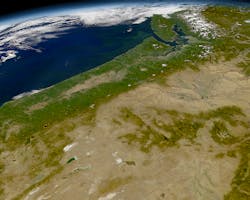First USDA Forecast Shows Normal Water Supply for the West
A normal water supply is predicted for much of the West, while the Southwest, Sierra Nevada region and Pacific Northwest are beginning the year drier than normal, according to data from the first 2015 forecast of USDA's National Water and Climate Center (NWCC). California, Arizona and New Mexico as well as parts of Colorado, Utah and Nevada are experiencing prolonged drought, focusing attention again on the winter snowfall.
In western states where snowmelt accounts for the majority of seasonal water supply, information about snowpack serves as an indicator of future water availability. Streamflow in the West consists largely of accumulated mountain snow that melts and flows into streams as temperatures warm in spring and summer. NWCC scientists analyze the snowpack, air temperature, soil moisture and other measurements taken from remote sites to develop the water supply forecasts.
Overall, the basins of the Missouri, Colorado and Columbia rivers are expected to receive near normal streamflows.
In the Pacific Northwest, although rainfall during the fall months has been above average, the current snowpack is far below normal because of higher than normal temperatures.
The NWCC, part of USDA's Natural Resources Conservation Service, monitors conditions year-round and will continue to issue monthly forecasts until June. The water supply forecast is part of several USDA efforts to improve public awareness and mitigate the impacts of climate change, including drought and other extreme weather events. Through the creation of the National Drought Resilience Partnership, launched as part of the President's Climate Action Plan, federal agencies are working closely with states, tribes and local governments to develop a coordinated response to drought.
Source: The U.S. Department of Agriculture


